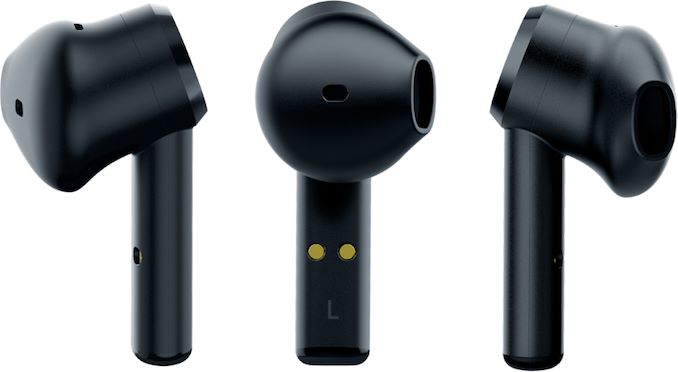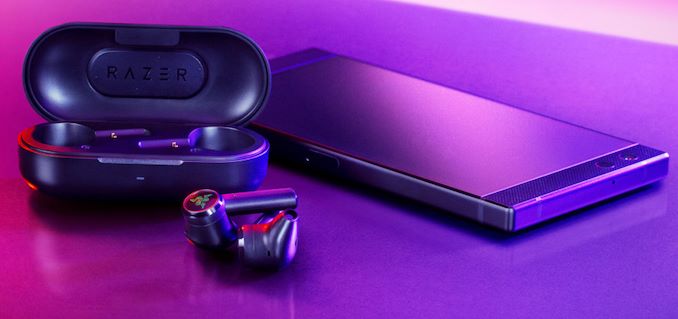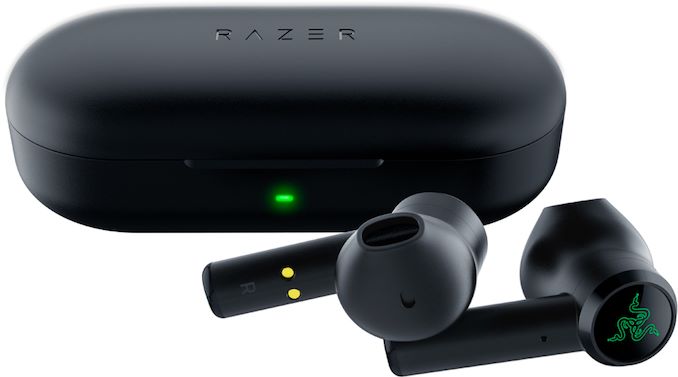Razer Cuts Bluetooth Audio Lag with Hammerhead Wireless Earbuds
by Anton Shilov on October 31, 2019 11:00 AM EST- Posted in
- Headset
- Razer
- Hammerhead

Razer this year has been on the rampage of new product announcements, bringing dozens of devices to the market and entering new categories. Adding to the company's lineup, this week the company introduced its Hammerhead wireless earbuds, which promise to reduce the audio lag that Bluetooth headphones are typically known for. The headset is compatible with all Bluetooth devices and supports touch controls to control calls, music, and virtual assistants.
Razer’s Hammerhead True Wireless earbuds use a 13-mm driver with a 20 Hz – 20 KHz frequency response, a 32 ± 15% Ohms impedance, and a 91 ± 3 dB @ 1 kHz sensitivity; as well as an omnidirectional MEMS microphone with a -42 ± 3 dB sensitivity, a ≥55 dB signal-to-noise ratio, and a 300 Hz – 5 kHz frequency response. Each earbud is equipped with a 275 mAh rechargeable Li-Po battery, with Razer touting a battery life of up to three hours.
The headset connects to smartphones (or other devices) using ‘a customized ultra-low latency’ Bluetooth 5.0 connection that reduces lag in Gaming Mode (enabled in a special app that accompanies the product) down to 60 ms. Low latency is particularly useful for playing games and watching movies as audio that is lagging behind video is clearly annoying. Razer does not say whether the fast BT connection is enabled by a special piece of hardware, though it looks like the manufacturer has customized its BT-enabling chip and radio using firmware tweaks.
Form-factor wise, the Hammerhead are black in-ear earbuds with silicon ear sleeves that are IP4X rated for sweat and splash protected. The earbuds are not meant to block all the environment noises and they also do not feature active noise cancellation, so they perform like the majority of headsets available today. As for controls, the earbuds can detect single press, double tap, triple tap, triple tap & hold last tap, and hold for two seconds gestures to control various aspects of their operation. The gestures can be customized in a companion app for Apple’s iOS and Google’s Android operating systems.
The Hammerhead True Wireless headset comes in a charging case that can charge it for up to four times, enabling up to 16 hours of total battery life, according to the manufacturer. The case connects to its power brick using a USB Type-C cable.
Razer’s Hammerhead wireless earbuds are now available directly from the company for $99.99 in the US and €119.99 in Europe.
Related Reading:
- Apple Unveils AirPods Pro: A New Design with Active Noise Cancellation
- The Sennheiser GSP670 Wireless Gaming Headset Review: Cutting The Cord
- Apple Launches 2nd Gen AirPods: Longer Talk Time & Hands-Free ‘Hey Siri’
- Sony’s Open-Ear Xperia Ear Duo Available for Pre-Order, Set to Ship in Late May
- Razer Unveils Optical Laptop Keyboard
- Razer’s Raptor 27 Gaming Monitor Now Available: QHD with 144 Hz FreeSync & HDR400
Source: Razer














18 Comments
View All Comments
p1esk - Thursday, October 31, 2019 - link
So what’s the catch behind the reduced latency? I mean if there wasn’t any the official Bluetooth would have implemented it, right?bloodgain - Thursday, October 31, 2019 - link
I have almost no lag on my truly wireless Samsung buds, and there's no catch that I notice. They work best with a Samsung phones, work well with most Android phones, and have pretty much normal lag on iPhone. So I think the catch is needing the right hardware and firmware cooperation. I assume the issue here is that BT is a general purpose spec; it badly needs an improved audio-only mode. I'd bet it gets one before long, now that several manufacturers seem to have solutions.boozed - Friday, November 1, 2019 - link
Did they do it with blockchain™?Agent Smith - Friday, November 1, 2019 - link
I’m wondering if their customised BT driver can be used elsewhere for obvious benefits?Quantumz0d - Friday, November 1, 2019 - link
I'm calling BS on Razer.AptX does LL with sub 320Kbps.
AptXHD does with Sub 500kbps.
LDAC does at 900kbps.
The AptX license is cheap so many devices get that HD one isn't and we know LDAC does ship only with Sony 1000MX series.
Plus all of these need Android to recognize the codec and support it over BT protocol. And all of these use BT connection but not LE mode (Low Energy) thus need higher battery and the fallback option if the connection is not able to keep up will deteriorate the quality of the datarate.
So many unknown bs problems for more price. Vs a regulat Hi Fi Implementation allowing for Studio class processing for instance my V30 has ESS9218P SoC DAC processor which allows user control for Filters and does all Input and Output audio processing upto 192KHz and pristine 24Bit Audio.
These BT sets have Li Ion tech which is planned obsolescence causing them to die after 1-1.5 years if you add IPx rating and seal them in repair is anyways impossible. But it will make them consumables like battery and fast charging them will further ruin them. Look at Tesla technology they have huge racks od batteries and high density thus having long life.
Apple of all fucking crony corporatism did this abomination instead of putting user at control with inbuilt Highly capable DACs like LG with ESS (ships on all high end PC motherboards) or AKM DACs found in Vivo took away and added junk BT audio, Apple latest trash has a garbage driver with sub 200kbps Audio with AAC. No FLAC at all and no control so much price.
Add DRM layer, Licensed for Google junk which was a copy of Made for iPeen by Apple adds more cost like Audeze Cypher Lighting for instance vs an inbuilt superior Audio solution without any bs of Digital DRM..since 3.5mm is pure Analog.
Its a shame that consumer is kept in dark by the press and shills and fanboys thus making the brilliant audio market riddle with half cookef garbage like this.
Going back in advancement... Sad however the Hi Fi Audio will flourish despite this junk. Of all Sony removed the jack while boasting a fat lineup of Hi Fi Audio gear esp when they have in house DACs in WM1Z..
Quantumz0d - Friday, November 1, 2019 - link
Oh also all of these have lag. Except AptXLL.So you pay for all these and still have mediocre junk datarate and lag as well.
Obliterated by dedicated DAC processor.
Now ask the questions to yourself.
TheSaltiestNut - Friday, November 1, 2019 - link
Absolutely beautifully said my friend.Not to even mention how the Funcl AI released for $49, using aptX for 60ms of latency. I imagine the same method used in these new Razer Hammerheads, considering both have the exact same delay amount. Only difference is Razer's marketing and tax.
ZolaIII - Saturday, November 2, 2019 - link
Actually all codecs you mentioned go a bit more up with bit rate but never mind that. Answer is Opus. Unfortunately their is no easy solution wired or wireless to get a decent sound quality & loud enough. LG does use Sabre DAC on it's ThinQ series paird with OPA dual AMP but unfortunately severly limited in where you need it most a 32 Ohm's output. Things get better with small BT receivers neck bands (from 22 to 35 mV) better one's do came with good DAC's (Sabre, Cirius, AKM...) but that's still sub pair to target of 50 mV. On the other hand decent portable USB DAC only solution are not that much popular & usually heavily overpriced like DragonFly Cobalt. Increasingly popular "HiFi" USB dongles are uther garbage. So there isn't an easy or cheap satisfactory solution. I will try to give some but remember that they all also have their down sides. Solution one buy good modular earphones with detachable cables and a decent neckband BT receiver. The Tin Audio T2 (around 40$ can get one for 32$ on 11.11)+ ZK BT neckband BT AptX HD QCC with MMCX connectors around 20$ all together around 60$. The BT transceiver (LDAC suport) & DAC Shanling UP2 around 75$, 35 mV at 32 Ohm's use what ever earbuds you like. The USB dac only the TempoTec Sonata iDSD around 70$ (can get one for 49$ on 11.11) has an older Sabre DAC but still capable enough, great Sabre AMP 75 mV @ 32 Ohm's built as a tank Stanles Steel but heavy & bulky for a portable AMP. Small DAP Shanling M0 around 100$, save your phone entirely or use it as BT transceiver or USB DAC. Those are a budget proposals in whatever better fits your needs from me.